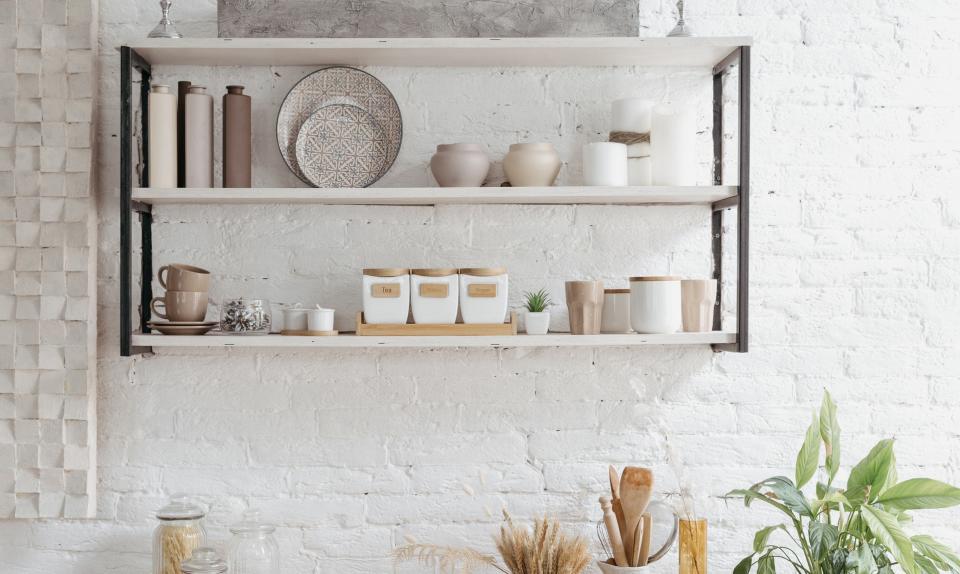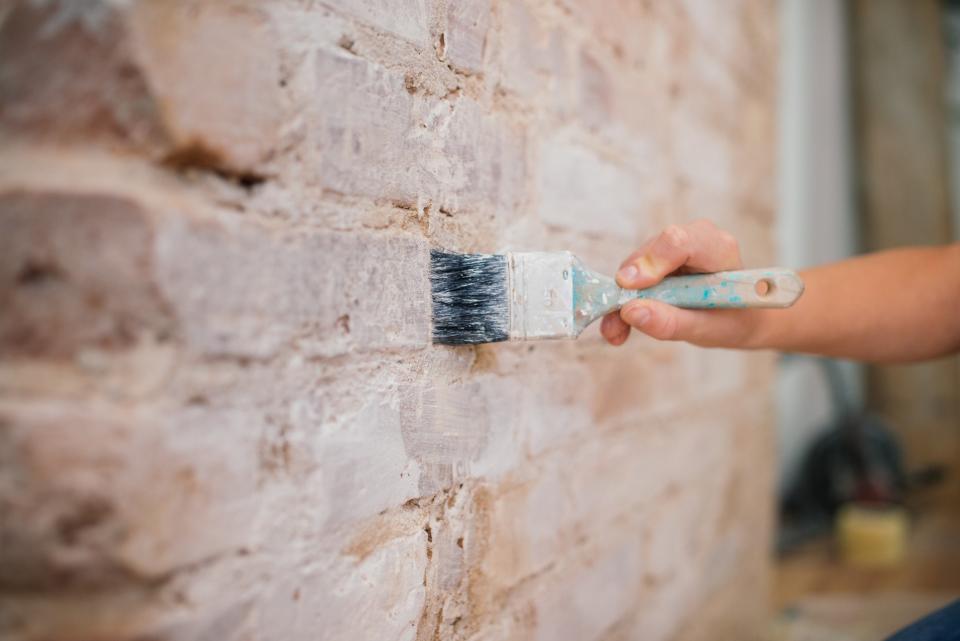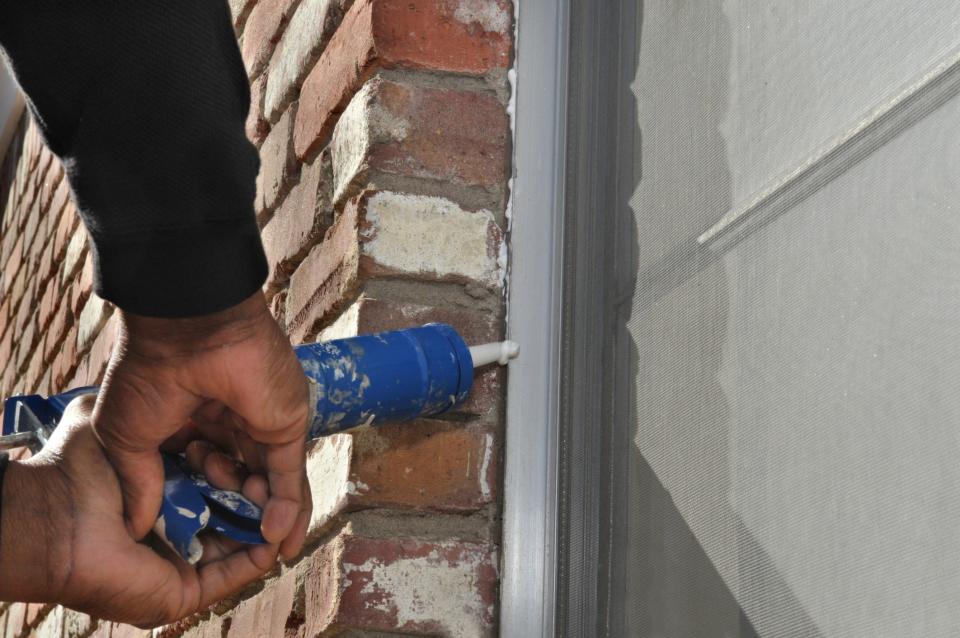How to Paint Brick the Right Way: A Step-by-Step Guide

Illustration: Ellie Schiltz/Getty Images
While many people appreciate the look of exposed red brick, others are inclined to paint brick to ensure that the material better complements the rest of a given space. “I think having brick in its raw state can make a room feel heavy in some instances, especially if you have a low ceiling,” says Kristin Harrison, the founder of Bungalow 10 Interiors. “Painting it can create a more warm and welcoming space but simultaneously keeps the character and texture that brick adds.”

Others will choose to cover brick if it isn’t in the best condition. “Painting brick is a nice option if the brick coloring or quality isn’t good,” says Sarah Snouffer, principal of Third Street Architecture. “It’s a cost-efficient option.”
Lastly, painting over a brick wall can yield cleaner looking results. “Raw brick and mortar are usually quite deeply textured and hold and generate dirt and dust, and painting or whitewashing it helps seal the brick and make it easier to maintain,” explains Ankie Barnes, a founding principal at BarnesVanze Architects.
Feeling inspired to grab a paintbrush and revamp that exposed brick wall with a coat of paint? If you’re looking to take on a DIY project and would like to learn how to paint brick yourself, you’ll want to keep reading. Here, we share the simple steps and materials needed in order to tackle those interior brick walls, as well as insights on what paint color homeowners should choose.
Materials and Tools Needed to Paint Brick:
Soap
Water
Trisodium phosphate (if necessary)
Step 1: Prep the brick
It’s important to thoroughly clean the brick before you paint it. Use a wire brush and soapy water to scrub the brick and remove any efflorescence (those streaky white deposits) or dirt. If you’re having trouble getting the surface clean, you can apply a mixture of trisodium phosphate (TSP) and water. Be sure to wear safety goggles and gloves when using TSP.
Once your brick has been cleaned, you’ll want to let it dry completely for 24 hours before painting. It’s also important to check for any cracks or structural problems that may require repointing or some professional help. Tape off any areas you don’t plan to paint.
Step 2: Paint the brick

Woman painting a brick wall.
Begin by applying a latex primer to the brick. If there are areas of the brick that have been affected by efflorescence or mildew, you may need to apply multiple coats. Let the primer dry completely. Definitely don’t skip out on the coat of primer, says Ashley Saltern, director of paint product management at PPG. “Apply it with a high-quality, nylon-polyester brush.”
Be sure to pay close attention to detail here as you begin your paint job. “If you see any defects in the brick itself after priming, fill any gaps of hole with a high-quality acrylic caulk or paintable polyurethane caulk,” Saltern instructs.
Then, use your roller or brushes to apply a paint formulated for masonry, or a latex paint, to the brick. (If you’re painting the interior of a fireplace, make sure you’re using heat-proof paint.) Painting pros may find that a paint sprayer is the easiest method, but brushes and rollers made for textured surfaces also work well. Make sure to push the paint into the tiny cracks and crevices. Apply a second coat if necessary. “It’s always best to start at the top and work your way to the bottom,” Saltern advises. “Keep a rag or an extra dry brush handy to catch drips along the way.”
Not sure what paint color to choose? There is no specific route that you must take when selecting a hue for your interior brick. “It can be painted an accent color to stand out or the same as wall color for a more toned down feel,” Snouffer says. “Neutrals are always a nice option that provides a subtle change with lots of texture.”
Those who are inclined to paint brick a neutral hue will want to heed to Harrison’s recommendations. She gravitates to whites and off-whites, such as Sherwin-Williams Roman Column and Benjamin Moore Simply White, colors that will shine in living rooms, bedrooms, and dining rooms alike.
That said, be mindful that white isn’t the best paint color selection for a brick fireplace unless you’re prepared to repaint often. “If you use a fireplace that is not wood-burning, you shouldn’t fear using a stunning white,” Saltern says, noting that soot therefore won’t cause any damage.
Step 3: Get creative with these tips and tricks
Instead of painting, consider staining your brick. This method works best on brick that’s in good condition, and it allows the texture of the surface to shine because the stain absorbs into the brick rather than coating it as paint does.
Never paint damaged or wet brick. The surface should always be clean, dry, and in good condition before painting, otherwise the process can cause more damage.
When cleaning your brick before painting, never use acidic cleansers. They will affect the final paint job.
Remove your painter’s tape before your finished area dries, but don’t move furniture back near the wall right away. Saltern recommends waiting one to two days after the area dries before doing so.

Caulking Gun in Use
What are the best colors for painting a brick wall?
Many designers encourage homeowners to paint brick a neutral hue. However, this depends on whether you’re painting a brick fireplace or wall, as well as the overall aesthetic desired.
Why do designers like to paint brick walls?
Designers like to paint interior brick walls in order to make a room feel more open, to camouflage damaged brick, and to diminish the appearance of dirt and dust.
What should someone do before painting a brick surface?
It’s imperative to begin any brick paint project by applying a coat of primer to the brick wall after using a wire brush and soapy water to clean off the area. Brick must dry for 24 hours before a paintbrush touches it.
Originally Appeared on Architectural Digest
More Great Stories From AD It Yourself
47 Kitchen Organization Ideas That Declutter Cabinets, Countertops, and More
The Cringiest DIY Trends According to TikTok’s Favorite Designers, Decorators, and DIY’ers
How to Propagate Pothos Plants at Home: A Step-by-Step Guide
Not a subscriber? Join AD for print and digital access now.
Browse the AD PRO Directory to find an AD-approved design expert for your next project.

